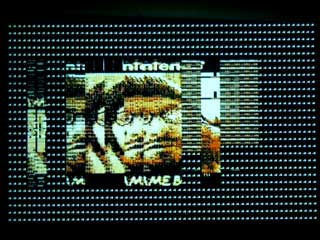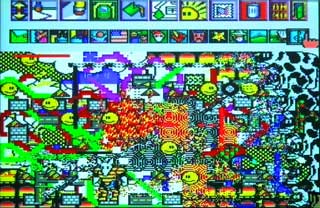SNES carts
The initial event that got me into considering Super Nintendos for visuals happened years earlier: someone stole my digital camera. I didn't have the money to buy a new one but I still wanted to take pictures. I still had an analog camera but the convenience of taking a photo and being able to look at it immediately had grown on me.


 I did have a gameboy, though. I had heard there was a digital camera for the gameboy. So I got one of those and loved it instantly. You can take 30 pictures that have a resolution of 128x112 pixels with black, white and two in between shades of grey. It teaches you to see the world in an all new way. I even bought and carried around a few of them to be able to "switch films".
I did have a gameboy, though. I had heard there was a digital camera for the gameboy. So I got one of those and loved it instantly. You can take 30 pictures that have a resolution of 128x112 pixels with black, white and two in between shades of grey. It teaches you to see the world in an all new way. I even bought and carried around a few of them to be able to "switch films".
There's some more Game boy photography in this game I made with my Like What? webthing.
One thing I was amazed of, but had no idea of how to use it, was having a live preview of everything you point it at, on your gameboy screen. I was thinking about doing an animation film with a gameboy camera, running off an actual Gameboy cartridge. Alas, this would have involved coding and I seem to never bring up the patience to learn that properly. The idea went to the huge "future projects"-pile in my head. Also, I learned about the Super Gameboy in the meantime, which is a complete Gameboy System minus screen plus some extra code so you can put it in your Super Nintendo to play Gameboy Games on your TV. You can even replace the colors. And that's where the Super Nintendos come into play.
 The Super Gameboy is so widely available, it turned up about 10 times at every fleamarket I visited. One came with the first SNESes I bought,
The Super Gameboy is so widely available, it turned up about 10 times at every fleamarket I visited. One came with the first SNESes I bought,
Basically, The first software I used to test my SNES wasn't even a SNES program. The Gameboy Camera has been a major part of the System for a very long time because it was the only way of bringing live footage in to a SNES. I've modded one of my GB cams so the head with the lens is extended with a gooseneck fitting. It also does a great job in producing psychedelic but gritty video feedbacks. The possibilities of the Game boy Camera are vast and plentiful, I might explain them in-depth at a later time.
 The second thing I tried was a trippy 'creativity game' called "fun'n games". This 'Mario Paint'-like package included a paint program that you could do insanely colourful pictures with. Also, there were two crappy games, a dressing puppet program called "style" and a neat sequencing program with samples of unrecognizable instruments, animals, explosions and screaming people. Eva used to have a really good time with this one when she came by to visit me in my studio. The only problem was, that in order to get a picture like the one above, I had to spend some time to paint it. Time that I usually don't have while playing live, so I don't use it that frequently.
The second thing I tried was a trippy 'creativity game' called "fun'n games". This 'Mario Paint'-like package included a paint program that you could do insanely colourful pictures with. Also, there were two crappy games, a dressing puppet program called "style" and a neat sequencing program with samples of unrecognizable instruments, animals, explosions and screaming people. Eva used to have a really good time with this one when she came by to visit me in my studio. The only problem was, that in order to get a picture like the one above, I had to spend some time to paint it. Time that I usually don't have while playing live, so I don't use it that frequently.
I bought some games, too, but most of them turned out a disappointment, because games rely on you playing them. If you don't do that, you get no movement. On the other Hand, scrambling the screen doesnt't make playing games easier, so chances are you die pretty soon, have a new sceen loaded that you don't really need just right now, then you have to go through some menu to go back to the Game, which doesn't look the same anymore because you had some bends active while the screen was loading and so on...
 There are exceptions. Well, I suppose, there are more exceptions, but I mostly used two games for visuals: Wolfenstein 3D and DOOM. As we all know, these are originally PC games that had to be ported to work on the Super Nintendo. The ports of both games really suck; at least if you're looking at them from a gamer's position.
There are exceptions. Well, I suppose, there are more exceptions, but I mostly used two games for visuals: Wolfenstein 3D and DOOM. As we all know, these are originally PC games that had to be ported to work on the Super Nintendo. The ports of both games really suck; at least if you're looking at them from a gamer's position.
Wolfenstein is completely cleaned of all the swastikas, Hitler doesn't have his small moustache anymore, and his name is "Staatsmeister" now. The nazis don't bleed if you shoot them and the dogs have been replaced by giant rats. Wow. Also, the Levels are much smaller, there's less enemies, the music is somewhat uninspired and there's only one song for all the levels.
As a weird glitch in game history, the only other game featuring the same engine is the hilariously demented 'Super Noah's Ark 3D'.
DOOM isn't as hilarious as that, it's just bad. It looks shitty, the controls are awkward and there's no way of saving.
Besides those quirks, these games are perfect for Visuals, because they're totally predictable, have strong images and add extra depth to the average 2D screens you know from Super Nintendos. Besides, I really like the historical dimension of them, being the first "first person shooters" ever. Especially because of all the babble about "Killerspiele" and how they're responsible for some idiots to decide suicide would be a lot more fun if some random people die as well. Wolfenstein is also pretty easy to hack because all the wall textures can be replaced easily with tile editing programs. I also hardcoded a permanent "God Mode" in there, so I can roam around more freely without being killed all the time.
To be able to do things like that I had to learn how to romhack. Well, sort of.
Over the course of my research, I came in touch with a big and vivid scene of romhackers and democoders that actually didn't give me very much info because I haven't been on their forums for a minimum of 3 years. I started visiting romhacking.net frequently where most of my questions were answered with: "Well, first you'll have to learn assembler for some years and then you can come back here and ask a little more precisely what you want, so we know you're not wasting our time blabla..."
There seems to be some kind of gap between software and hardware hackers and I guess, since I'm mostly on the hardware side, I was kind of confused by those peoples' mindset. I didn't quite get their point in acting that way, but the forums are filled up with valuable info and useful programs and they somehow seemed to be nice guys, only a bit overprotective or whatever, so I eventually did what they told me. Well, not by learning assembler, but by using the search function over and over again and eventually figuring out the stuff I needed my way. I had to learn a lot by trial and error, but that's my approach to most things anyway, so it wasn't that bad. While being there I eventually found several public domain demo roms that some guys did for testing their coding abilities on a certain hardware. You know, that demoscene thing.
Not only are these programs small and easy to handle, but they're also usually done for one reason: visual effects to the max! I still feel a little weird using those, because I'm not really sure if i'm actually stealing their code or merely borrowing it. I usually don't use them in their original form but e.g. exchange pictures or color palettes for my own and stuff like that. I don't know what kind of License they are published under, so I kinda decided it's OK to use them as footage for my live shows but I'd never go as far as selling something that is based on them. If someone from the demoscene reads this and has an opinion on this, please contact me, I'm open on discussing that issue.
If you're not from any of those kind of scenes, you might have wondered how it's possible to download files from the internet and then play them on a SNES. Yeah, I wondered, too. Until I found these sites:
snesdev.de
Rom Laboratory
Finally, hardware. Here, I felt a lot more at home again, because on these sites there are very nice tutorials on how to convert a Super Nintendo cartridge PCB to take ordinary Eproms. The process is pretty easy if you have an Eprom programmer and know how to solder. I was in the lucky position of having both, so I went out of "normal" SNES games pretty soon, exchanging them for a nice collection of carts with taped covers that have Words on nobody else understands.
